MySQL一些常用高级SQL语句详解
一、MySQL进阶查询
首先先创建两张表
mysql -u root -pXXX #登陆数据库,XXX为密码
create database jiangsu; #新建一个名为jiangsu的数据库
use jiangsu; #使用该数据库
create table location(Region char(20),Store_name char(20)); #创建location表,字段1为Region,数据类型为char,数据长度为20;字段2为Store_name,数据类型为char,长度为20.
insert into location values('North','Xuzhou'); #插入4条数据
insert into location values('North','Suqian');
insert into location values('South','Nanjing');
insert into location values('South','Suzhou');
create table store_info(Store_name char(20),Sales int(10),Date char(10)); #再创建一张store_info表
insert into store_info values('Xuzhou',300,'2020-12-08'); #插入4条数据
insert into store_info values('Suqian',249,'2020-12-07');
insert into store_info values('Nanjing',1500,'2020-12-05');
insert into store_info values('Suzhou',700,'2020-12-08');
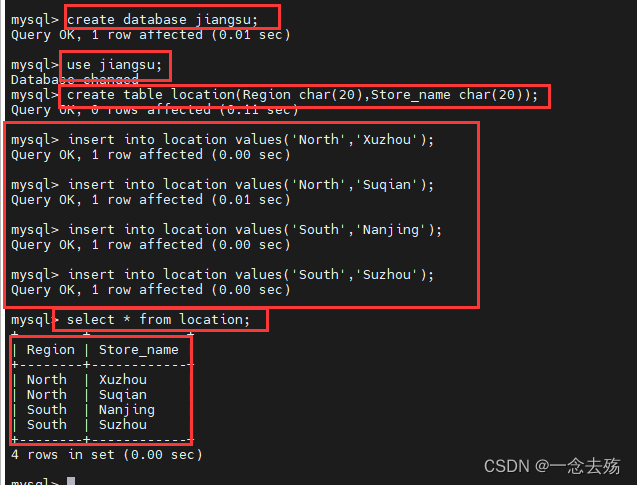
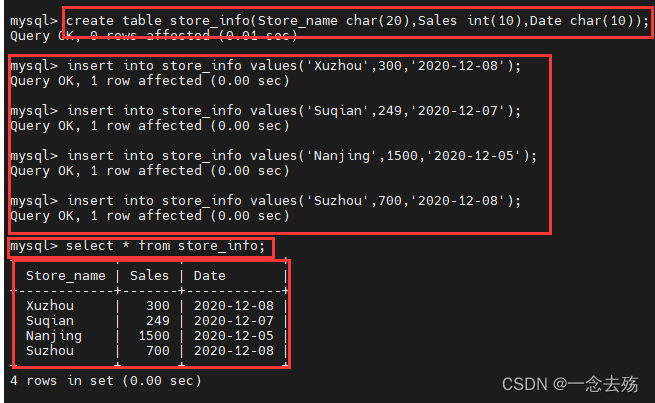
----------------select-------------------
select用于查询表格中的一个或多个字段的数据记录
语法格式:select 字段1,字段2,... from 表名;
select * from location; #查询location表中的所有字段,*表示所有,如果不嫌麻烦,当然也可以将所有字段都输进去
select Region from location; #查询location表中的Region的数据
select sales,Date from store_info; #查询store_info表中的sales,Date字段的数据----------------DISTINCT-------------------
DISTINCT用于将重复的数据压缩为一个
语法格式:select distinct 字段名 from 表名;
select distinct Store_name from store_info; #查询dtore_info表中的Store_name字段的数据,如有重复,则只显示一个----------------where-------------------
where用于带条件查询
语法格式:select 字段名 from 表名 where 条件语句;
select Store_name from store_info where sales=300; #查询store_info表中sales字段的值等于300的Store_name的数据
select Store_name from store_info where sales>500; #查询store_info表中sales字段的值大于500的Store_name的数据----------------and or-------------------
and,且,用于查询一个数据范围;or,或,用于查询包含条件语句的所有数据
语法格式:select 字段名 from 表名 where 条件1 and/or 条件2;
select Store_name from store_info where sales>250 and sales<1000; #查询store_info表中sales字段的值大于250,且小于1000的Store_name的数据
select Store_name from store_info where sales<250 or sales>1000; #查询store_info表中sales字段的值小于250,或者 大于1000的Store_name的数据
select Store_name from store_info where sales>1000 or (sales >200 and sales < 500); #括号的优先级高,所以先根据括号里的and条件语句进行筛选,然后再根据or进行筛选,最后查询最终筛选出来的数据;该语句先筛选出sales大于200且小于500的值,再使用or进行或的删选,最终筛选出来的结果应该是在200到500之间的值或者大于1000的值。
select Store_name from store_info where sales>1000 or sales >200 and sales < 500; #如果不加括号,and的优先级是比or要高的,也就是说,当一条条件语句中同时存在and和or(没有括号),会先执行and条件。----------------in-------------------
in用来显示已知值的数据,简单来说,in后面跟的是一个数据集合,查询语句会根据数据集合中的值进行筛选查询。not in 就是取数据集合中的反,不在数据集合中的数据。
语法格式:select 字段名1 from 表名 where 字段名2 in ('字段名2的值1','字段名2的值2,......');
select * from store_info where Store_name in ('Nanjing','Xuzhou'); #将Nanjing和Xuzhou的所有信息都查询出来。
注:in可以用or代替
上述语句等于:select * from store_info where Store_name='Nanjing' or Store_name='Xuzhou';----------------between...and-------------------
between 值1 and 值2 ,在值1与值2之间(值2 > 值1),该语句查询的是一个范围,包含值1和值2。其作用相在某一方面当于大于等于 ... and 小于等于 ... 。
语法格式:select 字段名 from 表名 where 字段名 between 值1 and 值2;
select * from store_info where Date between '2020-12-07' and '2020-12-10'; #查询store_info表中的Data的值在12-06与12-10之间的所有数据----------------通配符-------------------
通配符一般情况下和like一起使用进行模糊查询,模糊查询的概念就是将所有符合条件的数据全部查询出来,而等于号是精确查询,会直接将具体的某一数据查询出来
模糊查询的字符如下:
%:百分号表示0个,1个或多个字符
_:下划线表示单个字符
语法格式:select 字段 from 表名 where 字段 like '通配符';
select * from store_info where Date like '2020%'; #将Date的值为2020,后面随便(2020后有没有都行)的值全部查询出来
select * from store_info where Date like '2020-12-0_'; #将2020-12-0,后面只能匹配一个字符(必须存在且只能有一个)的所有数据查询出来----------------like-------------------
like,模糊查询,用于查询符合条件的所有数据,通常和通配符一起使用,语法和通配符一样的,因为是结合使用。
create database name;
use name;
create table stu_name(sname char(10));
insert into stu_name values('张');
insert into stu_name values('张三');
insert into stu_name values('张四');
insert into stu_name values('张无忌');
insert into stu_name values('一张纸');
insert into stu_name values('弓长张');
select * from stu_name where sname like '张%'; #查询所有张姓的名字,只要姓张就行
select * from stu_name where sname like '%张'; #查询所有最后一个字是张的姓名,前面无所谓
select * from stu_name where sname like '%张%'; #查询所有包含张的姓名,张字在姓在名都行
select * from stu_name where sname like '张_'; #查询所有张姓且只有两个字的名字
select * from stu_name where sname like '张__';(两条下划线) #查询所有张姓,且必须为三个字的名字
select * from stu_name where sname like '_张%'; #查询所有第二个字为张的名字
select * from stu_name where sname like '张_%'; #查询所有张姓,名字至少包含两个字的名字
select * from stu_name where sname like '张%_'; #查询所有张姓,名字至少包含两个字的名字,该语句和上面的查询结果一样,但理解是不同的。----------------order by-------------------
order by 用于关键字的排序
语法格式:select 字段 from 表名 [where 条件语句] order by 字段 asc/desc;
asc:按字段升序,默认为asc
desc:按字段降序
select Store_name,Date,sales from store_info order by sales; #按照sales升序排列后,查询name、date和sales
select Store_name,Date,sales from store_info order by sales desc; #按照sales降序排列后,查询name、date和sales
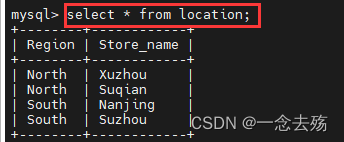
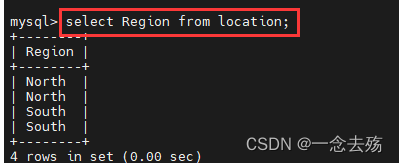
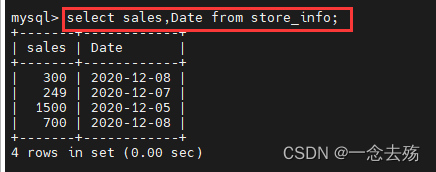
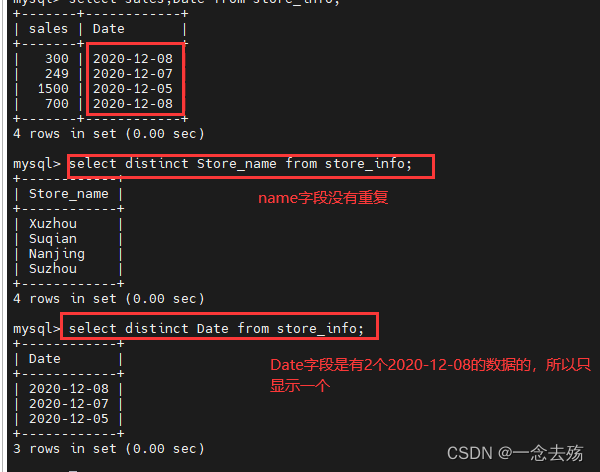
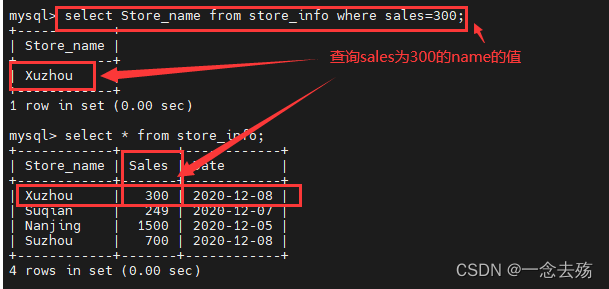
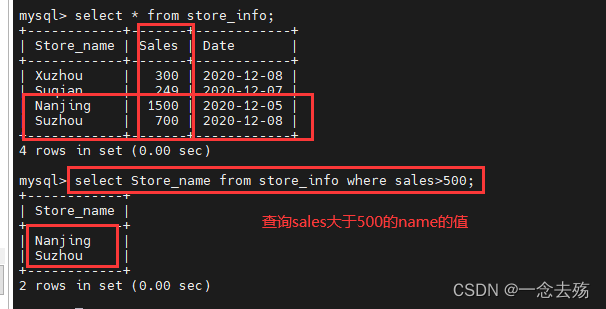
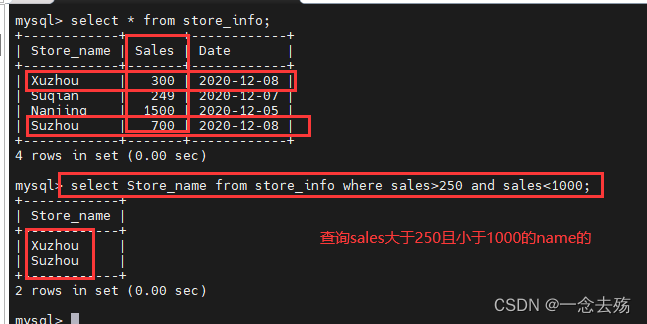
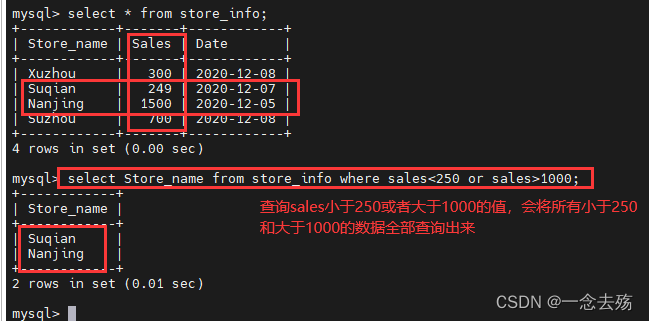
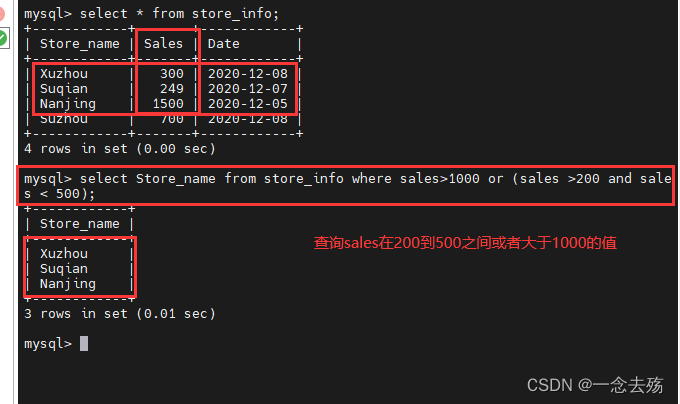
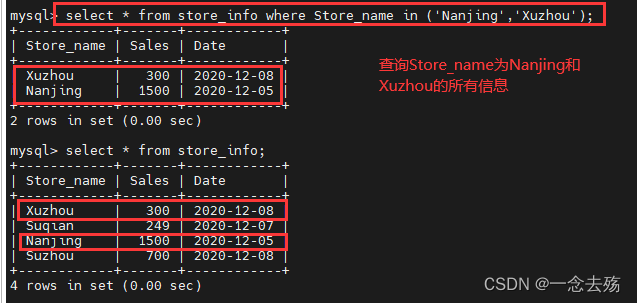

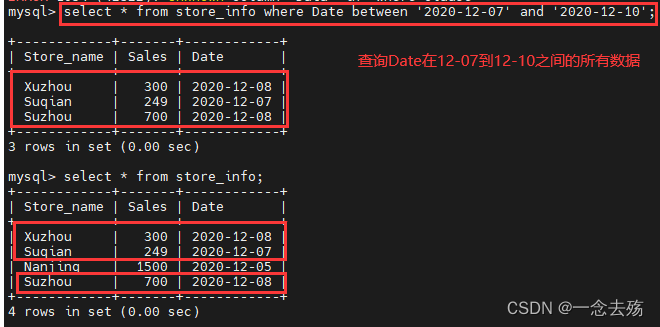
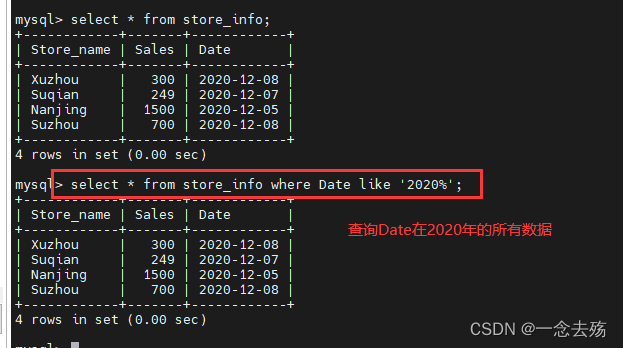

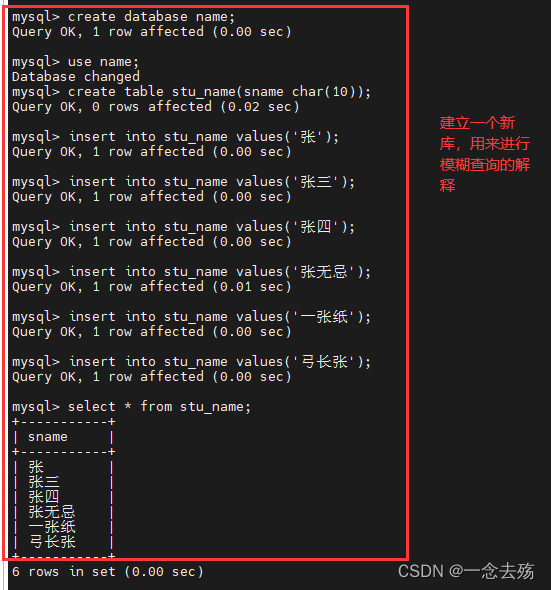








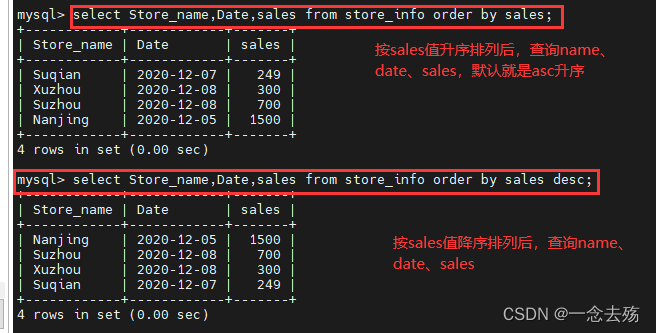
二、MySQL数据库函数
-------------数学函数-------------------
abs(x) #返回x的绝对值
rand() #返回0到1之间的随机数
mod(x,y) #返回x除以y的余数
power(x,y) #返回x的y次方
round(x) #返回离x最近的整数
round(x,y) #保留x的y位小数四舍五入之后的值
sqrt(x) #返回x的平方根
truncate(x,y) #返回x截断为y位小数的值
ceil(x) #返回大于或等于x的最小整数
floor(x) #返回小于或等于x的最大整数
greatest(x,y,z,...) #返回集合中最大的值
least(x,y,z,...) #返回集合中最小的值
---------------------------------------------
select abs(-1),rand(),mod(5,2),power(2,3),round(1.75);
select round(3.1415926,5),sqrt(2),truncate(3.141592653,4),ceil(5.2),floor(3.2),greatest(1.61,2.54,0.87),least(5.23,8.71,4.13);



--------------聚合函数--------------------
avg() #返回指定列的平均值
count() #返回指定列中非空值的个数
min() #返回指定列的最小值
max() #返回指定列的最大值
sum(x) #返回指定列的所有值的和
------------------------------------------
select avg(sales) from store_info; #查询sales的平均值
平均值的另一种方法:
select sum(sales)/(select count(sales) from store_info) from store_info;select count(Date) from store_info; #统计Date的数据个数,包括重复的值,但不包括空值
select count(distinct Date) from store_info; #统计Date的数据个数,重复的数据只统计一次,不包括空值
select count(*) from store_info; #全部统计,包括空值,count(*)扫描全表
select min(sales) from store_info; #查询sales的最小值
最小值的另一种方法:
select sales from store_info order by sales limit 1;select max(sales) from store_info; #查询sales的最大值
最大值的另一种方法:
select sales from store_info order by sales desc limit 1;select sum(sales) from store_info; #查询sales的和

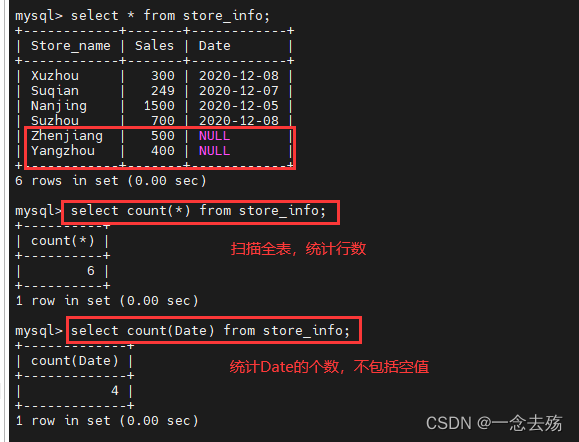
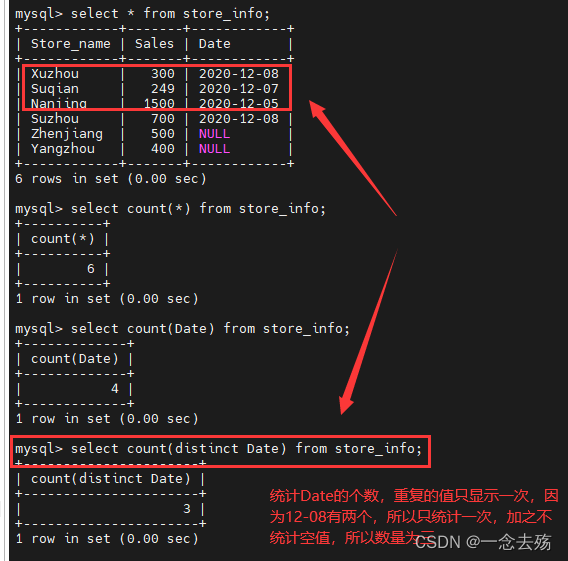
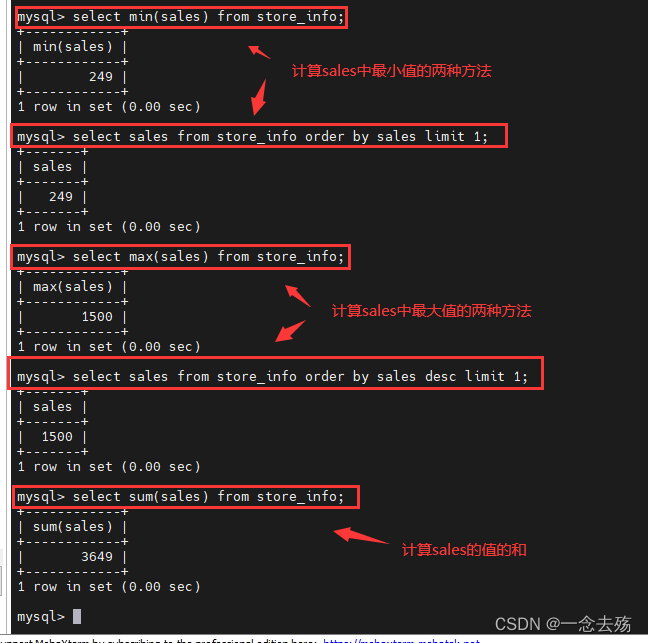
-----------------字符串函数--------------------
trim() #返回去除指定格式的值
concat(x,y) #将提供的参数x和y拼接成一个字符串
substr(x,y) #获取字符串x中第y个位置开始的字符串,跟substring()函数作用相同
substr(x,y,z) #获取字符串x中第y个位置开始,长度为z的字符串
length(x) #返回字符串x的长度
replace(x,y,z) #将字符串z替代字符串x中的字符串y
upper(x) #将字符串x中的所有字母变成大写
lower(x) #将字符串x中的所有字母变成小写
left(x,y) #返回字符串x中的前y个字符
right(x,y) #返回字符串x中的后y个字符
repeat(x,y) #将字符串x重复y次
space(x) #返回x个空格
strcmp(x,y) #比较x和y,返回的值可以为-1,0,1
reverse(x) #将字符串x反转select concat(Region,Store_name) from location where Store_name='Xuzhou'; #将location表中Store_name='Xuzhou'的Region,Store_name的值拼接在一起
select Region || ' ' || Store_name from location where Store_name='Xuzhou'; #在my.cnf中开启了PIPES_AS_CONCAT模式后,可以使用 || 代替concat函数,将多个字符串拼接在一起
select substr(Store_name,3) from store_info where Store_name='Suqian'; #将Suqian的第3个字符往后的所有字符截取出来
select substr((select Region || ' ' || Store_name from location where Store_name='Xuzhou'),1,5); #将上一条拼接的字段的第1到5个字符截取出来
select trim([[位置] [要除移的字符串] from] 字符串);
#位置:leading(开头),tariling(结尾),both(开头及结尾)
#要除移的字符串:从字符串的开头、结尾,或开头及结尾除移的字符串,缺省时为空格
select trim(leading 'Xu' from 'Xuzhou'); #将Xuzhou开头的Xu去掉select Region,length(Store_name) from location; #查询location表中的Region字段的值和Store_name的值的长度
select replace(Region,'th','thern') from location; #将location表中的Region字段的值包含th的替换为thern,然后返回。
------------------group by-------------------
group by用于对查询结果进行汇总分组,通常是结合聚合函数
一起使用,group by有一个原则,凡是在group by后面出现的
字段,必须在select后面出现。凡是在select后面出现、且未在
group by后面出现的字段,必须出现在group by后面。
语法格式:select 字段1,sum(字段2) from 表名 group by 字段1;select Store_name,sum(sales) from store_info group by Store_name order by sales;
------------------having----------------------
having用来过滤由group by语句返回的记录值,通常与group by语句联合使用。having语句的存在弥补了where关键字不能与聚合函数联合使用的不足。
语法格式:select 字段1,sum(字段2) from 表名 group by 字段1 having (函数条件);
select Store_name,sum(sales) from store_info group by Store_name having sum(sales) >1000;-------------------别名----------------------
别名包括字段别名和表的别名,当一张表的名字或者表中的某一个字段名过于冗长时,可以使用别名将之代替,从而降低查询的失误率。
语法格式:select 字段 [AS] 字段别名 from 表名 [AS] 表格别名;
select Store_name NAME,sales SALE from store_info;------------------子查询---------------------
子查询通常用于连接表格,在where子句或者having子句中插入另一个SQL语句。
语法格式:select 字段1 from 表格1 where 字段2 [比较运算符] (select 字段2 from 表格2 where 条件语句);括号里的select语句是内查询,括号外的select语句是外查询
select Region from location where Store_name=(select Store_name from store_info where sales=300); #比较运算符,可以是=、>、<或者>=、<=select sales from store_info where Store_name in (select Store_name from location); #也可以是in、between...and、like等

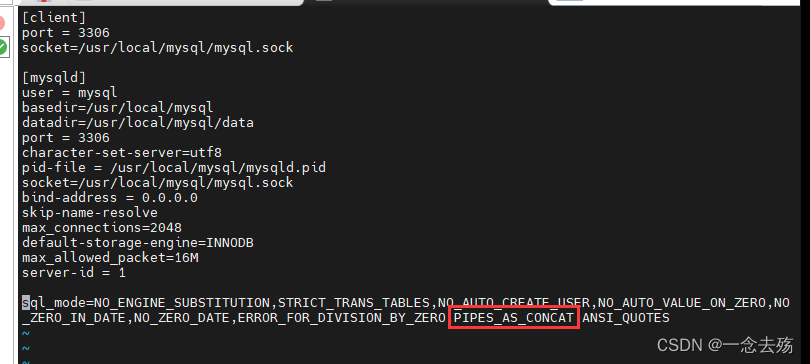


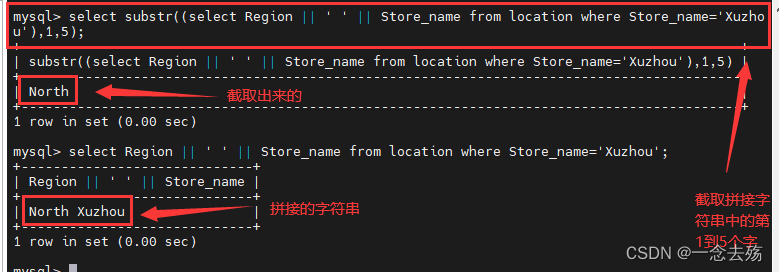

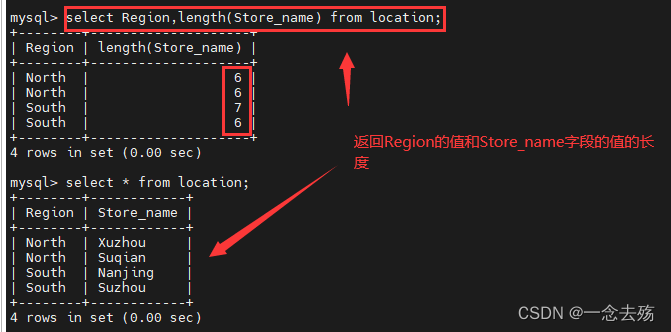
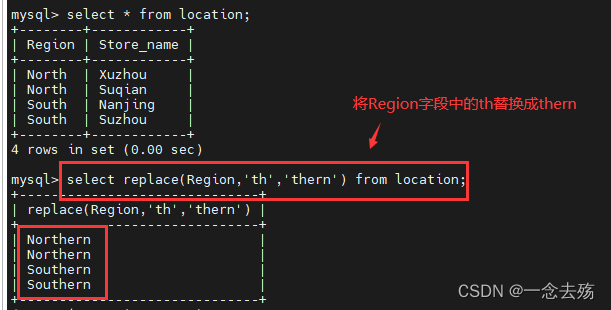
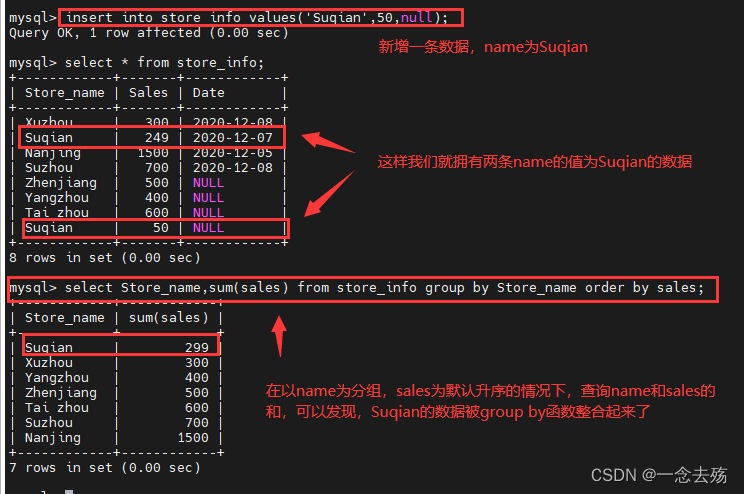

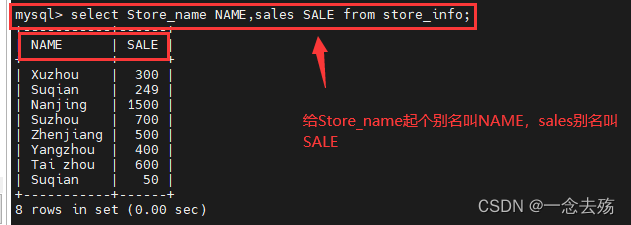
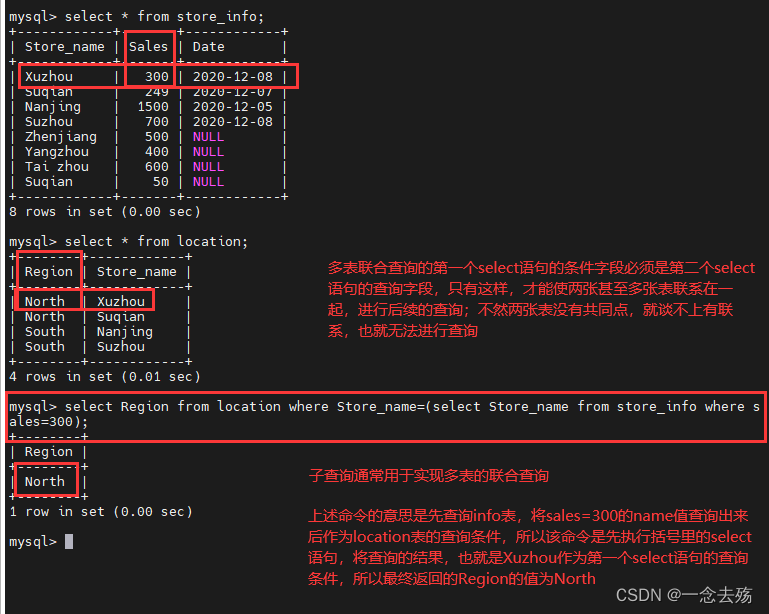
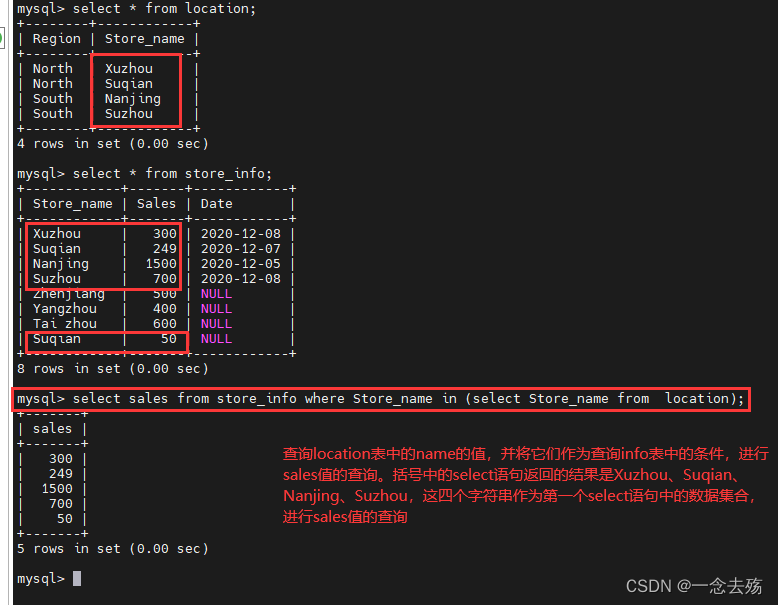
------------------exists---------------------
exists用来测试内查询有没有产生任何结果,类似布尔值
是否为真。如果内查询产生了结果,则将结果作为外查询
的条件继续执行,如果没有结果,那么整条语句都不会产
生结果。
语法格式:select 字段1 from 表1 where exists (select 字段2 from 表2 where 条件语句);
select sum(sales) from store_info where exists (select * from location where Region='North'); #
#先执行内查询语句,即在location表中查询Region为North的所有数据,如果存在,则执行外查询语句;如果不存在,就不执行外查询
------------------连接查询-----------------------
inner join(内连接):内连接只返回两个表中字段的值相等的数据,即两表的交集
left join(左连接):返回包括左表中的所有记录和右表中联结字段相等的记录
right join(右连接):返回包括右表中的所有记录和左表中联结字段相等的记录
select * from location left join store_info on location.Store_name=store_info.Store_name; #左连接select * from location right join store_info on location.Store_name=store_info.Store_name; #右连接
select * from location inner join store_info on location.Store_name=store_info.Store_name; #内连接法1
SELECT * FROM location A, store_info B WHERE A.Store_Name = B.Store_Name; #内连接法2
SELECT Region REGION, SUM(B.Sales) SALES FROM location A, store_info B WHERE A.Store_Name = B.Store_Name GROUP BY Region; #查询两表中name值相等的Region的值和sales的和,并按照Region字段进行分组,REGION是字段Region的别名,SALES是sum(sales)的别名,A是表location的别名,B是info表的别名
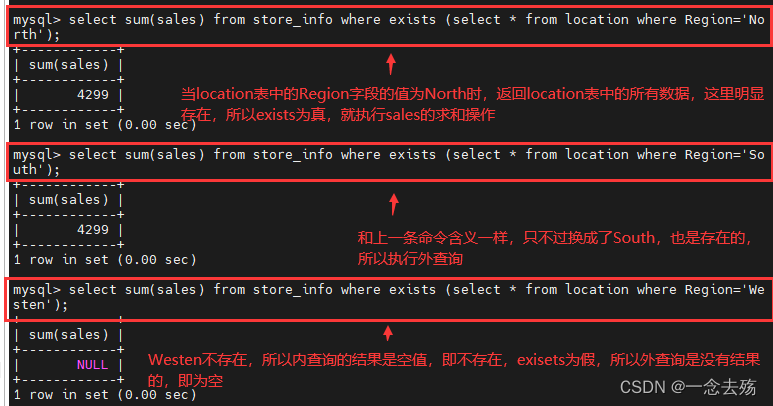
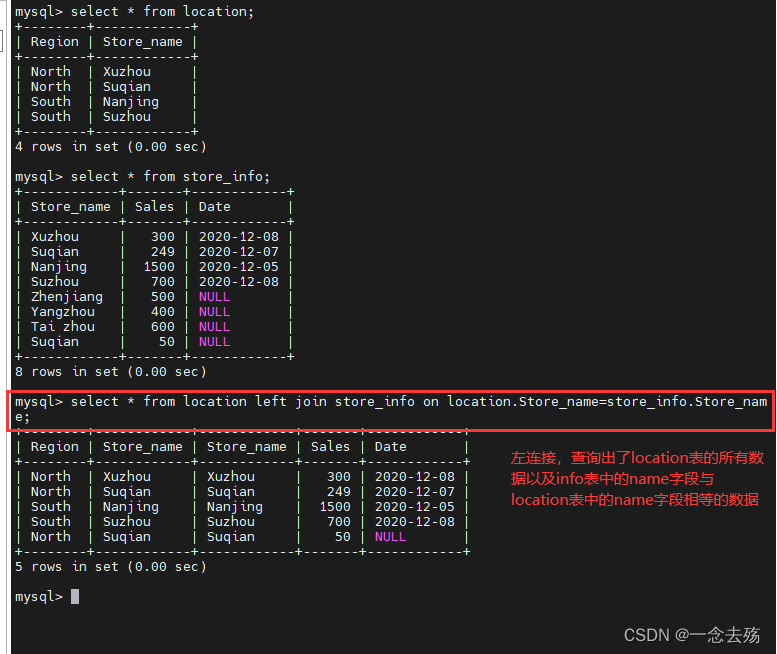
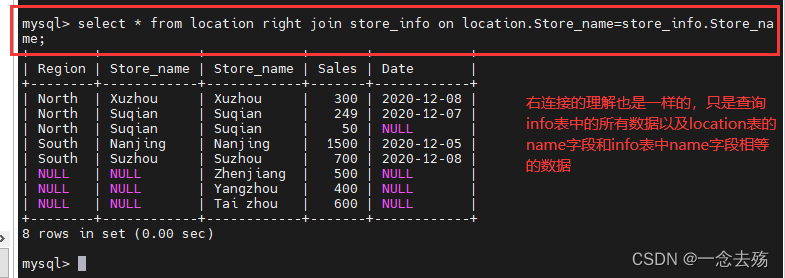



---------------------view-----------------------
view,视图,视图是一张虚拟的表,通常用于保存多表联合查询出来数据,这样可以极大的减轻SQL语句的复杂度,在执行n张表的联合查询时,视图可以起到很大的便利作用。视图跟表格的不同是,表格中有实际储存数据记录,而视图是建立在表格之上的一个架构,它本身并不实际储存数据记录。而视图不会因为退出数据库而消失。
语法格式1:create view 视图名 as 查询语句; #创建视图
语法格式2:drop view 视图名; #删除视图
show tables from 库名; #该命令不仅可以查看库所包含的表,也可以查看有哪些视图------------------------union-------------------------
union,联集,其作用是将两个SQL语句的结果合并起来,两个SQL语句所产生的字段需要是同样的数据记录种类
union :生成结果的数据记录值将没有重复,且按照字段的顺序进行排序
union all :将生成结果的数据记录值都列出来,无论有无重复
语法格式:[select 语句 1] UNION [all] [SELECT 语句 2];
select Store_name from location union select Store_name from store_info;select Store_name from location union all select Store_name from store_info;
-------------------求交集的几种方法------------------
存在重复数据:
1.select A.Store_Name FROM location A inner join store_info B on A.Store_Name = B.Store_Name;
2.select A.Store_name from location A,store_info B where A.Store_name=B.Store_name;
3.select A.Store_name from location A inner join store_info B using (Store_name);无重复数据:
1.想要得到无重复数据其实很简单,在重复数据的查询语句select后加上distinct去重即可。
select distinct A.Store_Name FROM location A inner join store_info B on A.Store_Name = B.Store_Name;2.使用子查询,在内查询中查询info中的name字段,并将之作为外查询的条件,这样,外查询的查询语句的范围就只能在内查询查出的数据中进行。(子查询实际上就是变相的内查询)
select distinct Store_name from location where Store_name in (select Store_name from store_info);3.使用左查询,将location和info表进行左查询,会查询出location表中的所有name字段的值以及info表中与location表中name的值相等的数据,再使用distinct进行去重
select distinct A.Store_name from location A left join store_info B using(Store_name) where B.Store_name is not null;4.使用级联查询,union all会将两张表的所有数据都连接到一起,这时只需要通过count()函数将大于1的数值统计出来,即可实现查询两表的共同数值。
select Store_name,count(A.Store_name) from (select Store_name from location union all select Store_name from store_info) A group by A.Store_name having count(A.Store_name)>1 ;---------------------无交集---------------------
既然我们可以查询出有交集的数据,那么取反就可以实现无交集的查询了
select distinct Store_name from location where Store_name not in (select Store_name from store_info);
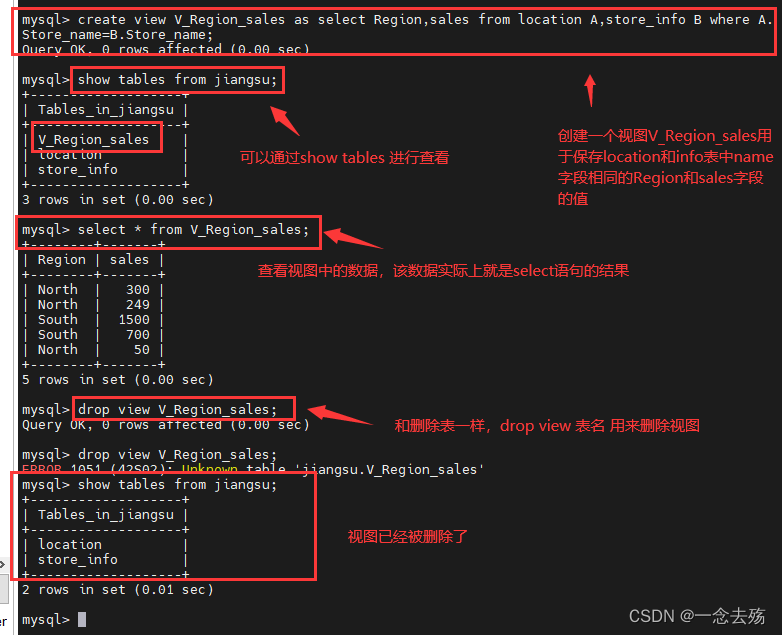
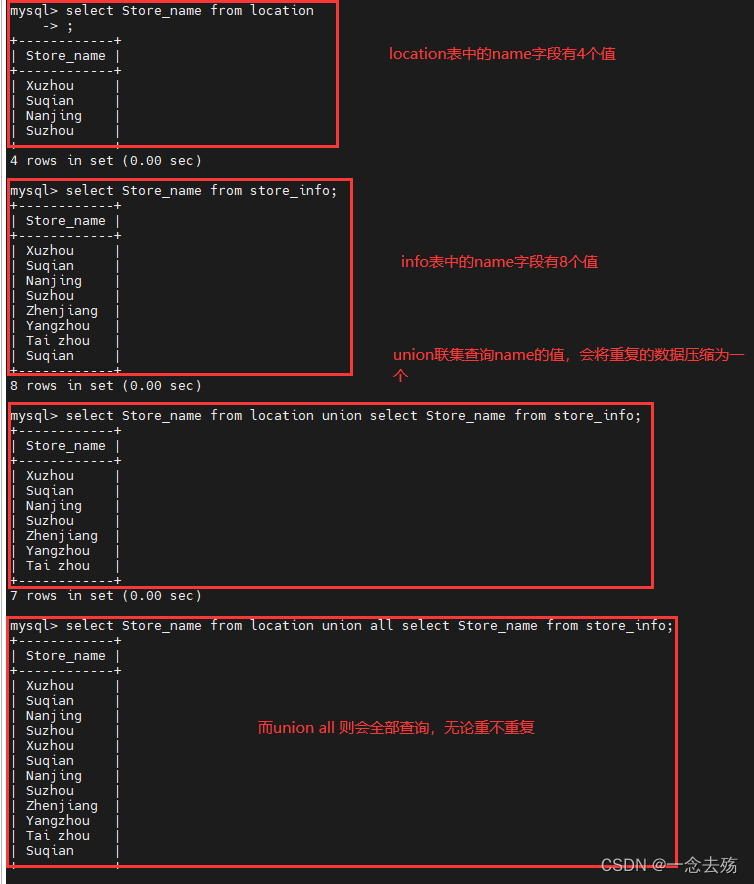
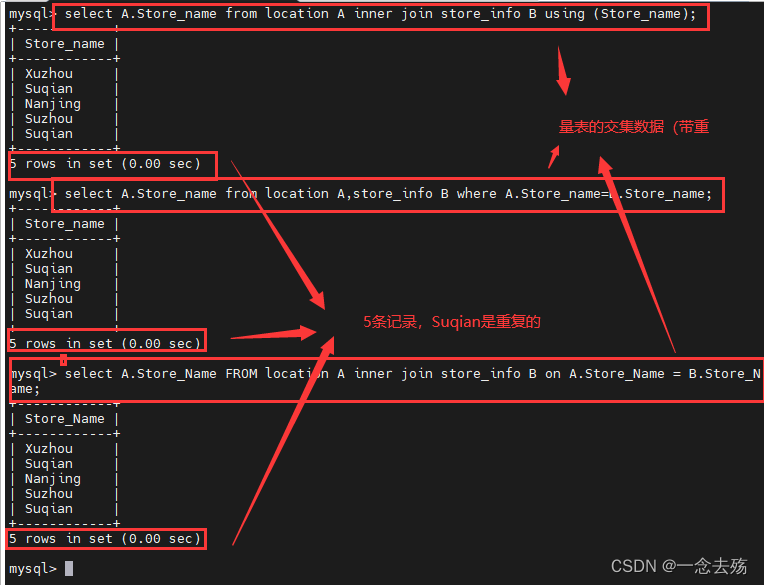


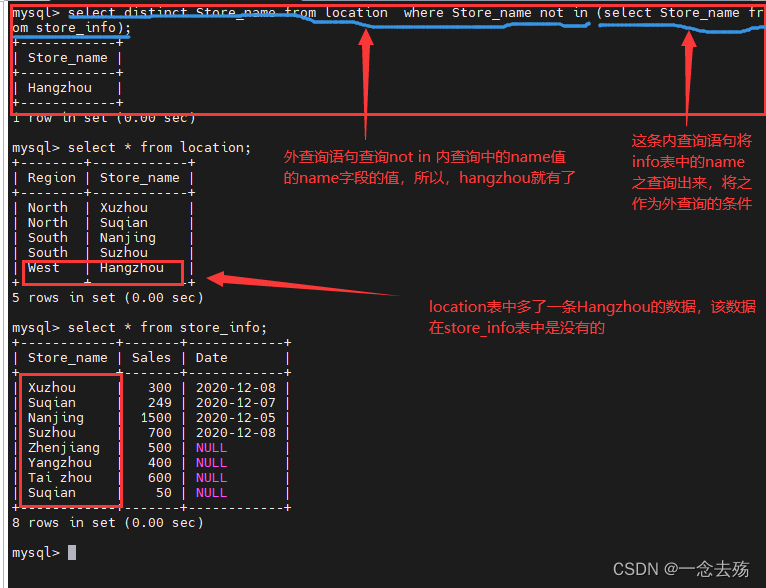
---------------------case---------------------
case是SQL语句用来做为when-then-else(当...就...否则...)之类逻辑的关键字
语法格式:
select case 字段名
when 条件1 then 结果1
when 条件2 then 条件2
.....
[else 结果n]
end
from 表名;
--------空值(NULL) 和 无值('') 的区别----------
1.无值的长度为 0,不占用空间的;而 NULL 值的长度是 NULL,是占用空间的。
2.IS NULL 或者 IS NOT NULL,是用来判断字段是不是为 NULL 或者不是 NULL,不能查出是不是无值的。
3.无值的判断使用=''或者<>''来处理。<> 代表不等于。
4.在通过 count()指定字段统计有多少行数时,如果遇到 NULL 值会自动忽略掉,遇到无值会加入到记录中进行计算。
create table city(name char(10)); #新建city表
insert into city values ('beijing'); #插入三个值
insert into city values ('nanjing');
insert into city values ('xuzhou');
insert into city values (''); #插入两个无值
insert into city values ('');
insert into city values (null); #插入两个空值
insert into city values (null);
select * from city; #查询city表的所有值
select length(name) from city; #查询name字段值的长度
select count(name) from city; #统计name字段的值,空值会被忽略
select length('111'),length(null),length(''); #比较有值、空值、无值的长度
select * from city where name is null; #查询name为空的值
select * from city where name is not null; #查询name字段不为空的值
select * from city where name = ''; #查询name值为无值的数据
select * from city where name <> ''; #查询name字段不为无值的数据,空值会被忽略

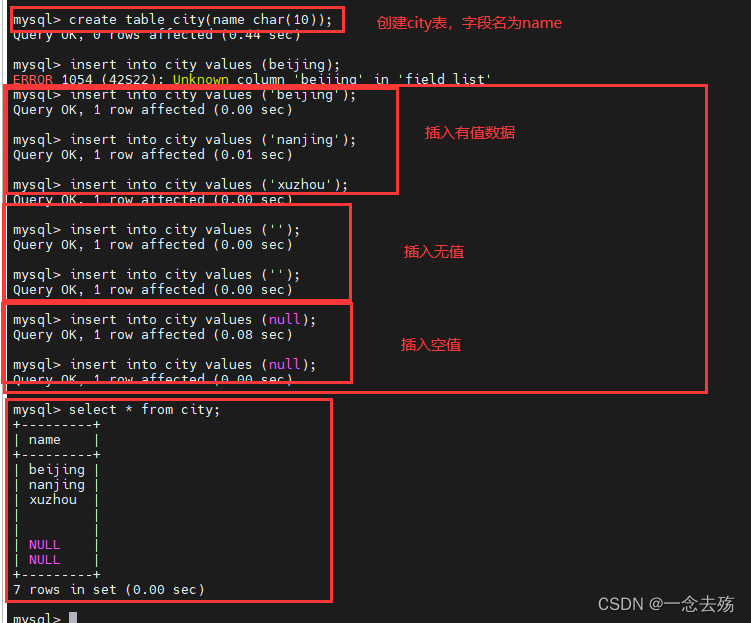
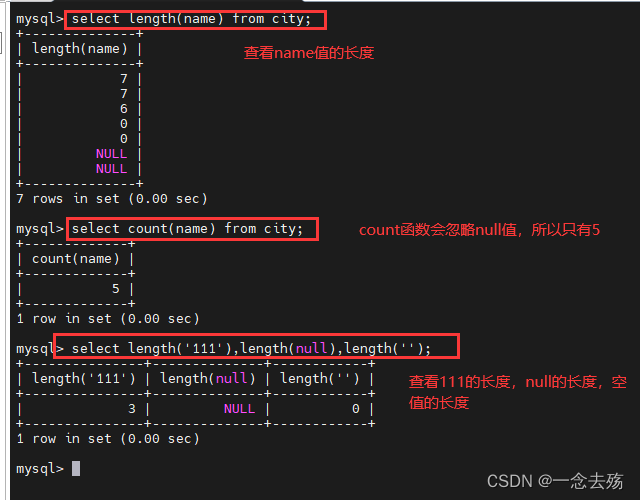
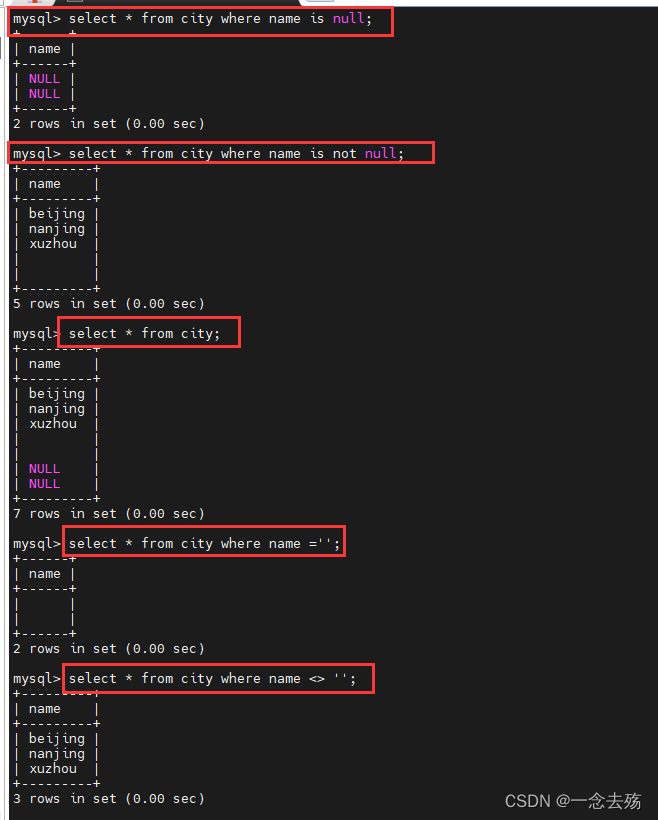
--------------------正则表达式-------------------------
^:匹配文本的开始字符
$:匹配文本的结束字符
.:匹配任何一个字符
*:匹配零个或多个在它前面的字符
+:匹配前面的字符1次或多次
字符串:匹配包含指定的字符串
p1|p2:匹配p1或p2
[...]:匹配字符集合中的任意一个字符
[^...]:匹配不在括号中的任何字符
{n}:匹配前面的字符串 n 次
{n,m}:匹配前面的字符串至少n次,至多m次
语法格式:select 字段 from 表名 where 字段 REGEXP {模式};
select * from city where name regexp 'zhou'; #匹配数据中带zhou的
select * from city where name regexp 'nan|bei'; #匹配数据中有nan或bei的
select * from city where name regexp '^[xnb]'; #匹配以xnb任一字符开头的数据
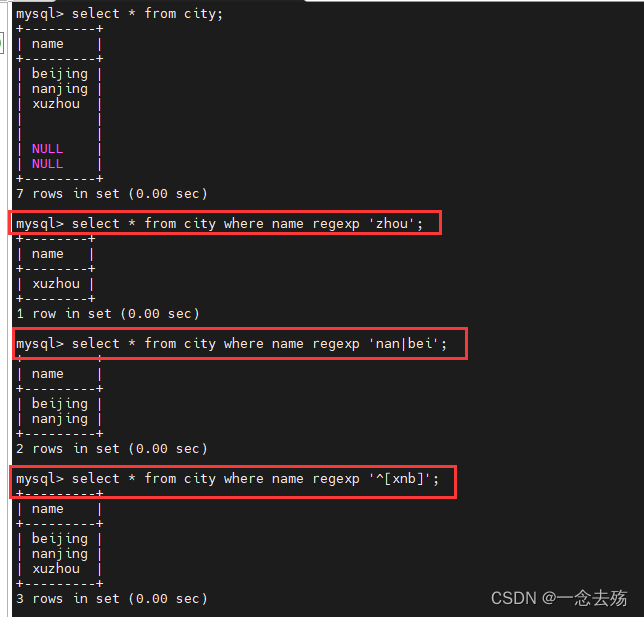
三、MySQL存储过程
存储过程是一组为了完成特定功能的SQL语句集合。
存储过程在使用过程中是将常用或者复杂的工作预先使用SQL语句写好并用一个指定的名称存储起来,这个过程经编译和优化后存储在数据库服务器中。当需要使用该存储过程时,只需要调用它即可。存储过程在执行上比传统SQL速度更快、执行效率更高。
存储过程的优点:
1、执行一次后,会将生成的二进制代码驻留缓冲区,提高执行效率
2、SQL语句加上控制语句的集合,灵活性高
3、在服务器端存储,客户端调用时,降低网络负载
4、可多次重复被调用,可随时修改,不影响客户端调用
5、可完成所有的数据库操作,也可控制数据库的信息访问权限
------------------创建存储过程-----------------------
delimiter !! #将语句的结束符号从分号;临时改为两个!!(可以是自定义)
create procedure Proc() #创建存储过程,过程名为Proc,不带参数
-> begin #过程体以关键字 BEGIN 开始
-> select * from Store_Info; #过程体语句
-> end $$ #过程体以关键字 END 结束
delimiter ; #将语句的结束符号恢复为分号------------------调用存储过程-----------------------------
call Proc;
------------------查看存储过程----------------------------
show create procrdure [数据库.]存储过程名; #查看某个存储过程的具体信息
show create procedure proc;
show procedure status [LIKE '%Proc%'] \G
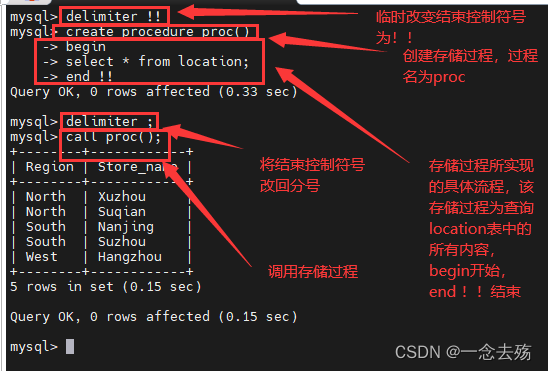

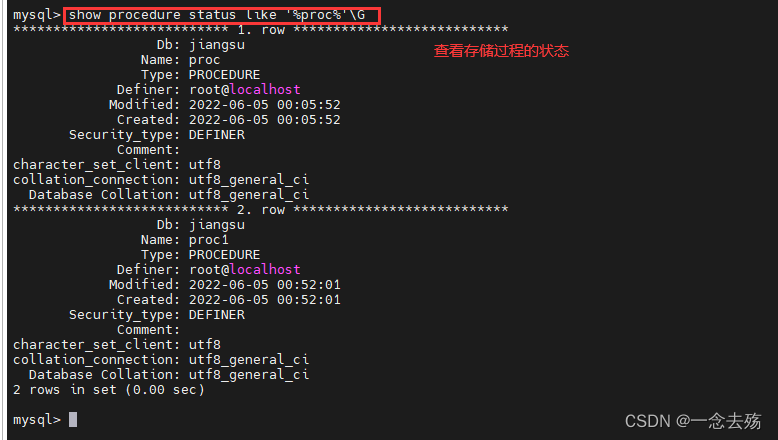
----------------存储过程的参数--------------------
IN 输入参数:表示调用者向过程传入值(传入值可以是字面量或变量)
OUT 输出参数:表示过程向调用者传出值(可以返回多个值)(传出值只能是变量)
INOUT 输入输出参数:既表示调用者向过程传入值,又表示过程向调用者传出值(值只能是变量)实例:
delimiter !
create procedure proc1(in inname char(10))
-> begin
-> insert into city values(inname);
-> select * from city;
-> end !
delimiter ;
call proc1('hangzhou');------------------删除存储过程----------------------
存储过程内容的修改方法是通过删除原有存储过程,之后再以相同的名称创建新的存储过程。
drop procedure if exists 存储过程名; #仅当存在时删除,不添加if exists时,如果指定的过程不存在,则产生一个错误
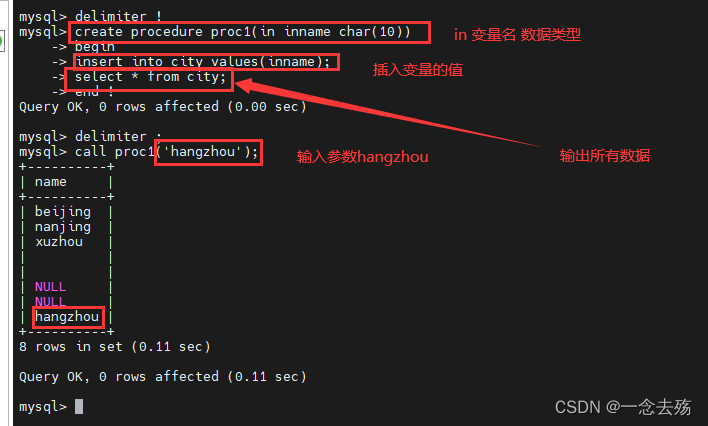
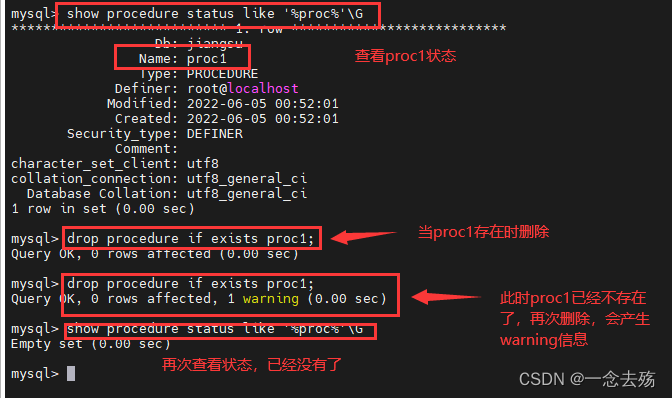
##存储过程的控制语句##
create table num (id int);
insert into num values(10);
(1)条件语句if...then...else ...end if
delimiter !!
create procedure proc2(in nid int)
-> begin
-> declare var int; #declare 变量名 数据类型 来创建一个变量
-> set var=nid*3; #设置变量的参数
-> if var>=10 then #if-else判断
-> update num set id=id+1;
-> else
-> update num set id=id-1;
-> end if; #结束判断
-> end !!
delimiter ;
call proc2(6);(2)循环语句while...do...end while #用法和if一样,while的话必须要给定义的变量自增的过程,否则会死循环,可以参考shell中的while语句
delimiter !!
create procedure proc3()
-> begin
-> declare var int(10);
-> set var=0;
-> while var<6 do
-> insert into num values(var);
-> set var=var+1;
-> end while;
-> end !!
delimiter ;
call proc3;
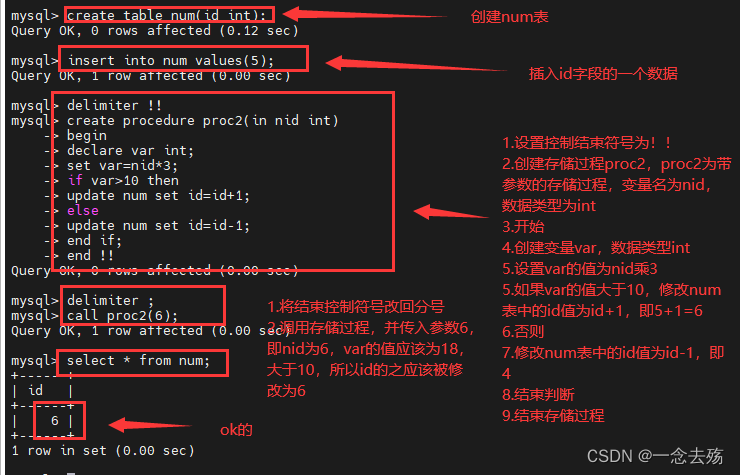
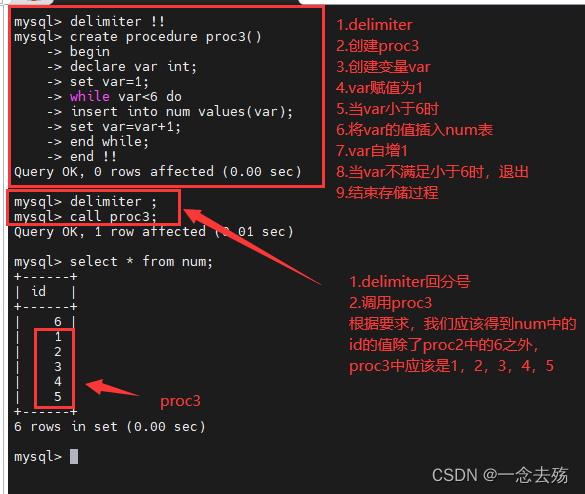
总结
- 各种函数的使用
- 多表查询时的字段所属的表
- 存储过程的整体流程
- 灵活运用所学知识,举一反三
到此这篇关于MySQL一些常用高级SQL语句详解的文章就介绍到这了,更多相关MySQL SQL语句内容请搜索服务器之家以前的文章或继续浏览下面的相关文章希望大家以后多多支持服务器之家!
原文链接:https://blog.csdn.net/qq_40707090/article/details/125050499
1.本站遵循行业规范,任何转载的稿件都会明确标注作者和来源;2.本站的原创文章,请转载时务必注明文章作者和来源,不尊重原创的行为我们将追究责任;3.作者投稿可能会经我们编辑修改或补充。










